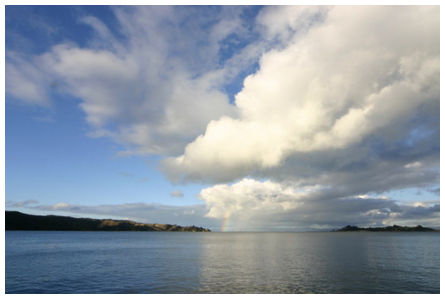- Study in AustraliaAustralian Universities/CollegesPrograms by faculty AusAustralian VisasLife in Australia
- Study In New ZealandNew Zealand UniversitiesPrograms by Faculty NZNew Zealand VisasLife in New Zealand
- Study in CanadaUniversities/Colleges in CANADAPrograms by faculty CanadaCanadian VisasLife in Canada
Climate
New Zealand Climate and Weather
New Zealand weather and climate is of paramount importance to the people of New Zealand, as many New Zealander's make their living from the land. New Zealand has mild temperatures, moderately high rainfall, and many hours of sunshine throughout most of the country. New Zealand's climate is dominated by two main geographical features: the mountains and the sea.
New Zealand Seasons
New Zealand does not have a large temperature range, lacking the extremes found in most continental climates. However, New Zealand weather can change unexpectedly—as cold fronts or tropical cyclones quickly blow in. Because of this, you should be prepared for sudden changes in weather and temperature if you're going hiking or doing other outdoor activities.
- Spring - September, October, November
- Summer - December, January, February
- Autumn - March, April, May
- Winter - June, July, August
New Zealand Temperatures
New Zealand has a largely temperate climate. While the far north has subtropical weather during summer, and inland alpine areas of the South Island can be as cold as -10 C in winter, most of the country lies close to the coast, which means mild temperatures, moderate rainfall, and abundant sunshine. Because New Zealand lies in the Southern Hemisphere, the average temperature decreases as you travel south. The north of New Zealand is subtropical and the south temperate. The warmest months are December, January and February, and the coldest June, July and August. In summer, the average maximum temperature ranges between 20 - 30ºC and in winter between 10 - 15ºC.

New Zealand Regional Temperatures
The following temperatures are mean daily maximum and minimum temperatures in Celsius and Fahrenheit for New Zealand. Rainfall is indicated as the average rainfall days per season.
|
| Spring | Summer | Autumn | Winter | ||||
| Bay of Islands | High | Low | High | Low | High | Low | High | Low |
| Temperature (C) | 19 | 9 | 25 | 14 | 21 | 11 | 16 | 7 |
| Temperature (F) | 67 | 48 | 76 | 56 | 70 | 52 | 61 | 45 |
| Rain Days/Season | 11 | 7 | 11 | 16 | ||||
| Auckland |
|
|
|
|
|
|
|
|
| Temperature (C) | 18 | 11 | 24 | 12 | 20 | 13 | 15 | 9 |
| Temperature (F) | 65 | 52 | 75 | 54 | 68 | 55 | 59 | 48 |
| Rain Days/Season | 12 | 8 | 11 | 15 | ||||
| Rotorua |
|
|
|
|
|
|
|
|
| Temperature (C) | 17 | 7 | 24 | 12 | 18 | 9 | 13 | 4 |
| Temperature (F) | 63 | 45 | 75 | 54 | 68 | 55 | 59 | 48 |
| Rain Days/Season | 11 | 9 | 9 | 13 | ||||
| Wellington |
|
|
|
|
|
|
|
|
| Temperature (C) | 15 | 9 | 20 | 13 | 17 | 11 | 12 | 6 |
| Temperature (F) | 59 | 48 | 68 | 55 | 63 | 52 | 54 | 43 |
| Rain Days/Season | 11 | 7 | 10 | 13 | ||||
| Christchurch |
|
|
|
|
|
|
|
|
| Temperature (C) | 17 | 7 | 22 | 12 | 18 | 8 | 12 | 3 |
| Temperature (F) | 63 | 45 | 72 | 54 | 65 | 46 | 54 | 37 |
| Rain Days/Season | 7 | 7 | 7 | 7 | ||||
| Queenstown |
|
|
|
|
|
|
|
|
| Temperature (C) | 16 | 5 | 22 | 10 | 16 | 6 | 10 | 1 |
| Temperature (F) | 61 | 41 | 72 | 50 | 61 | 43 | 50 | 34 |
| Rain Days/Season | 9 | 8 | 8 | 7 | ||||
New Zealand Sunshine
Most places in New Zealand receive over 2,000 hours of sunshine a year, with the sunniest areas—Bay of Plenty, Hawke's Bay, Nelson and Marlborough—receiving over 2,350 hours. As New Zealand observes daylight saving, during summer months daylight can last up until 9.00 pm.
New Zealand experiences relatively little air pollution compared to many other countries, which makes the UV rays in our sunlight very strong during the summer months. In order to avoid sunburn, visitors should wear sunscreen, sunglasses, and hats when they are in direct summer sunlight, especially in the heat of the day (11 am - 4 pm). While summer is sunnier than the other seasons, most regions in New Zealand have a relatively high proportion of sunlight during the winter months.
New Zealand Rainfall
New Zealand's average rainfall is high—between 640 millimetres and 1500 millimetres—and evenly spread throughout the year. As well as producing areas of stunning native forest, this high rainfall makes New Zealand an ideal place for farming and horticulture (see above chart for the average days of rainfall).

New Zealand Summer
New Zealand's summer months are December to February, bringing high temperatures and sunshine. Days are long and sunny, nights are mild. Summer is an excellent time for walking in the bush and a variety of other outdoor activities. New Zealand's many gorgeous beaches are ideal for swimming, sunbathing, surfing, boating, and water sports during summer.
New Zealand Autumn
March to May are New Zealand's autumn months. While temperatures are a little cooler than summer, the weather can be excellent, and it is possible to swim in some places until April. While New Zealand's native flora is evergreen, there are many introduced deciduous trees. Colourful changing leaves make autumn a scenic delight, especially in regions such as Central Otago and Hawke's Bay, which are known for their autumn splendour.
New Zealand Winter
New Zealand's winter months of June to August bring colder weather to much of the country, and more rain to most areas in the North Island. Mountain ranges in both islands become snow-covered, providing beautiful vistas and excellent skiing. While the South Island has cooler winter temperatures, some areas of the island experience little rainfall in winter, so this is an excellent time to visit glaciers, mountains, and other areas of scenic beauty.
New Zealand Spring
Spring lasts from September to November, and New Zealand's spring weather can range from cold and frosty to warm and hot. During spring buds, blossoms, and other new growth bursts forth throughout the country and new born lambs frolic in the fields just before dusk. Both Alexandra in Central Otago and Hastings in Hawke's Bay celebrate spring with a blossom festival. If you're into white water rafting, this is the time when melting spring snow makes river water levels excitingly high!
Recommended Clothing
Dress is informal and relaxed on most occasions. Smart casual clothes are acceptable at most restaurants and night-spots. Men are generally not expected to wear suits and ties, except in a few of the top formal bars and restaurants in major cities. In summer a light jacket or sweater should be included in your luggage should the weather turn cooler or you visit higher altitudes. You can expect some rain, so include a light rainproof jacket or coat. If visiting between May and September, pack warm winter garments and layer your clothing.
For more information, please contact one of our offices
Study in Australia | Study in the UK | Study in Malaysia | Study in Canada | Study in the USA | Study in New Zealand













